|
Jane
Redmile
1800 - 1883
|
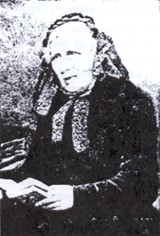 |
Few people approach the state of grace we have come to know as saintliness and
perhaps only one person in the history of Bourne is so remembered. She was Jane Redmile, daughter of a yeoman farmer from Dyke, whose unyielding faith,
selfless service and sense of charity singled her out as a special person in her
lifetime and her memory shines undimmed today as an example of the perfect life.
In the closing years of the 19th century, her name conjured up the quaint figure
in homely garb, often seen on errands of mercy or attending the church she loved
so well and which she had served for 65 years, a stooping form because she lived
to be old and bent and grey but it had been a life spent in all things good and
true. “She could neither strive nor cry”, wrote her biographer Benjamin Wyles,
“but the unobtrusive, gentle influence of her life was potent for good.”
Jane was born at Dyke on 10th May 1800 in the stone cottage that still stands
overlooking the village green. Her father, William Redmile (born 1772), had
moved there from Ryhall, near Stamford, after marrying a local girl, Ann Campin
(born at Bourne in 1776). They had six children, Jane being the eldest to
Campain (sic), John, Mary Ann, Elizabeth and Harriet.
In November 1817, tragedy struck the family when her father was badly hurt in an
accident while blasting for a new well on the farm. He survived his injuries after being
nursed by Ann for fourteen weeks but lost his sight and so the breadwinner had
been struck down at a time when a vexatious lawsuit threatened the future of
their home. Jane, then only 17, took over the responsibilities for home and
family, looking after her five brothers and sisters, while her mother opened a
shop to raise sufficient money for their needs.
Every avenue to earn a penny was explored, selling sugar at one penny a portion
while living themselves on dry bread and Jane even took in additional home
employment known as down work, plucking geese for the fine feathers to make
quilts, exacting work by candlelight so repetitive that she often fell asleep
but dreamed of the task in hand and woke to find that her work of past hours had
been plucked to pieces. Eventually, she was forced to abandon this labour for
fear of fire if the candle wax burned too low.
Jane’s teenage youth was passed in continual labour yet she found time to attend
the Baptist Church at Bourne, walking the two miles there and back twice on
Sundays for school and service. Meanwhile, the other children were growing up
and beginning to leave home and so Jane opened a grocery shop in Eastgate,
Bourne, where she soon became known among the neighbours for her charity and
goodwill. Most lived in unsanitary conditions and drunkenness was rife but Jane
spread the gospel of cleanliness and temperance and then decided that education
would also be a benefit.
She added a small circulating library to the business and tried her hand at
composition and, still fired by her religious fervour, set herself the task of
learning Greek and Hebrew in order that she could read the bible in the
languages in which it was originally written. Soon, her reputation spread and
both clergy and laymen with widely divergent views sought her company for
discussion and debate, always conducted with patience and tolerance and her
personal humility could only leave others with a deep feeling of love and
respect.
During this period, Jane had been saving money with one purpose in mind, that of
opening a Baptist chapel at Morton, two miles north of Dyke. She felt that the
village was enclosed in a moral and spiritual darkness and although services had
been held in the homes of various non-conformist believers, they had been
vigorously opposed by the parson, the Rev Thomas Holdsworth, and the squire,
William Parker, who controlled most of the land and properties. But Jane had
bided her time until she heard of a cottage for sale and bought it for use as a
chapel and soon services, prayer meetings and a Sunday School were being held
there regularly.
Jane had resisted attempts by the squire to purchase the cottage and thwart her
scheme but as time went by, he began to see the fruits of her labour in
improving the morals of the village and withdrew his opposition. But the small
chapel soon became inadequate and land was offered by John Gibson, a corn
merchant from Bourne, for a new one that was opened on Sunday 21st June 1846
after Jane had taken on the burden of raising most of the money herself. The old
chapel, lighted by dripping candles, continued in use until April 1876 when a
more commodious building with schoolrooms was opened and this building continues
in use today.
|
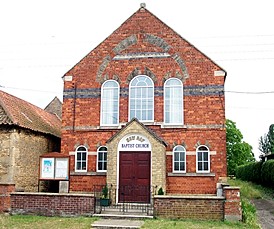 |
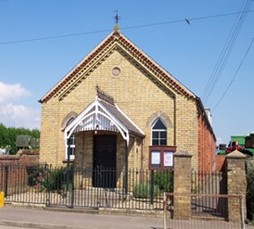 |
|
The Baptist chapels at Morton (left) and Dyke
(right). |
By now, Jane needed to spend more time at home to care for her ailing parents,
one blind the other weak, and so she turned her attention to Dyke. She had
already established a school in the village at her own cost and in 1843, a
building was completed and this continued in service for 27 years but was
eventually demolished because it lay on the route of the new Bourne to Sleaford
railway line. Then in 1861, she bought a small property for Sunday School
meetings that were held until the present Baptist Chapel was opened in 1879 and
is still in use.
She was now comfortably situated, the owner of 61 acres of land at Dyke that was
rented out and brought in a modest income, as well as the proceeds from the shop
in Eastgate. After the death of her parents, her mother having died on 18th January
1846 and her father on 5th September 1858, Jane lived for a while with her
nephew William Garner at his home in Dyke and then retired from business and left the
village for Bourne, living alone at a small house in Church Street for several
years, busy with her reading and bible study, her patchwork and sewing, visited
by many friends and still doing good works, quietly and unobtrusively, paying
pressing debts for others, sending parcels of necessities to needy people and always ready with
a word of sympathy or compassion for those bereaved or distressed by the ills of
the world. Yet she still had the time and mental energy to ponder on questions
of faith, meeting regularly with theologians, scholars and writers on Sunday
afternoons.
But her health began to decline and she suffered spasms and fainting fits and
with some reluctance, in 1880 was persuaded to go and live with her sister
Elizabeth who had married a Bourne merchant, William Wyles, at their home in Elm
Terrace. She resisted the idea of losing her independence for some weeks but
finally succumbed and went quietly, knowing there was no sensible alternative.
She was now an old woman who needed care and attention although no invalid and
her faculties were in full vigour, still attending religious services and prayer
meetings and maintaining an active interest in the Sunday School where she
continued teaching as long as her strength allowed. On her way home, Aunt Jane,
as she had now become known, would be followed by a number of young people
wanting to speak with her and although far removed by reason of age, she felt
sufficiently young in heart to be one of them.
On Saturday 16th June 1883, the day before she died, there was a characteristic
incident at the Baptist Church where she had offered a bible as the prize to the
scholar completing the best set of texts on the subject of baptism. Jane was so
satisfied with the work submitted that she decided each should have a bible and
the books were distributed as she lay dying.
Her declining physical condition, complicated by a severe cold that threatened
bronchitis, finally took its toll although she had already anticipated the end
and had settled her affairs, giving instructions to relatives about her estate.
After breakfast on Sunday, she had her will read over again and signed it then
had a period of reading and conversation, her mind as active as ever. She
retired to rest but suffered a new attack and went into a coma and in the
afternoon, the pulse fluttered, hesitated, stopped and all was over. The cause
of death was certified as senile decay and that a small clot of coagulated blood
lodged in the brain due the exhausted state of the heart. Today, this would be
known as a stroke.
The minister at the Bourne Baptist Church, the Rev William Orton, later wrote
these lines which stand as her epitaph: “The gentleness and refinement of her
character were shown in courtesy to all, in esteem for the poorest, in her
recognition of the use of the lowest, both in human life and material things.
Nothing was high enough for pride, or low enough for contempt. Outwardly, her
life taught that true dignity is irrespective of rank or fortune, that with care
and thrift, the lowest may rise, that adverse circumstances may be controlled,
that it is in the power of all to inform themselves for the benefit of others.
Seeing her virtues, knowing that the same sources of strength are open to all,
those who honour her piety may follow her and, through faith and patience,
inherit the promises.”
The funeral was on Thursday 21st June and afterwards Jane was buried in the town
cemetery where several other members of the family are also interred. Since
then, the Redmiles have become part of the history of Dyke village although there is no
one with that name living there today. Life was hard during the latter years of
the 19th century and many emigrated seeking new opportunities, to Australia,
Canada and the United States, and descendents are now numerous. Jane is
remembered in Dyke by a new housing development called Redmile Close, named in
her memory by Bourne Town Council and the developers, M Parker and Sons
(Builders) Ltd, when the work was completed in November 2000, while on the other
side of the Atlantic, a proud family tradition continues.
Despite her simple lifestyle, Jane Redmile was a wealthy woman
which was revealed soon after her death when the trustees of her will sold off
many valuable family properties from which she had been paid an income during
her lifetime.
ESTATE SALE: Mr F G Shilcock offered for
sale by auction, at the Angel Hotel on Thursday last week, a valuable estate
belonging to the trustees of the late Miss Jane Redmile, of Dyke. Lot 1, a
parcel of arable land containing 9a. 3r. 2¼p. situate in the West Field, in
Bourne, and occupied by Mr Henry Goodyear under a lease expiring the 6th April
1886, and which lot is copyhold of the Manor of Bourne Abbots, was withdrawn,
the last bid being £450 by Mr John Redmile, of Spalding, and the reserve £500.
Lot 2, a close of freehold pasture land containing 4a. 2r. 10p. situate in the
East Field, in Bourne, and occupied by Mr W R Garner, was sold to W R Wherry,
Esq., for £450. Possession of this lot is to be given at Lady-day, 1885. Lot 3,
a parcel of arable land containing 11a. 0r. 5p. (2a. 1r. of which is freehold
and the remainder copyhold), situate in the Bourne South Fen, and occupied by Mr
George Brudenell, was withdrawn, Mr Sims, of Dyke, being the last bidder at
£365, and the reserve £420. Lot 4, a parcel of freehold arable land containing
12a. 3r. 35p., situate in Morton Fen, and occupied by Mr Edward Scotney, was
also withdrawn, the last bid of £460 being by Mr Wm. Wyles, of Bourne, and the
reserve declared £520. S W Andrews Esq., was the solicitor for the vendors. -
news report from the Grantham Journal, Saturday 6th October 1883.
|
PHOTOGRAPH ALBUM |
|
This remarkable photograph which is
believed to be that of Jane Redmile (seated) with a relative or
friend and a bible before her, was taken by William Redshaw in
the late 19th century and was unknown until his granddaughter,
Mrs Heather Nash, now living in Canada, visited Bourne and
brought with her copies of several glass plate negatives that
had survived from his archive and gave them to me for research.
The picture was most probably taken in the closing years of
Jane's life and I have dated it circa 1880, perhaps in May that
year to celebrate her 80th birthday. |
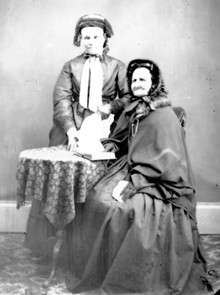 |
|
|
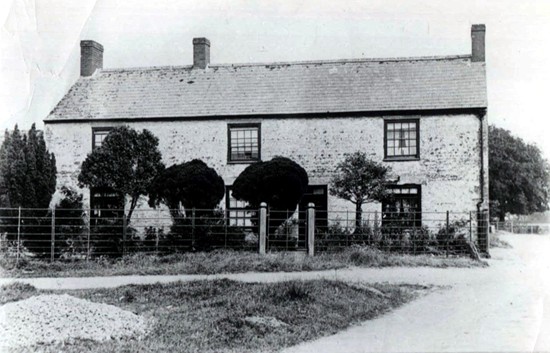 |
|
The cottage overlooking the village green
(above) where Jane Redmile was born from a photograph taken by her nephew,
William Redmile Garner, son of Harriet
Redmile, who had married John Garner in 1840. This copy of the
picture was taken
to America by her grand-nephew, Henry Herbert (Bert) Inkley, son of
her niece Mary,
when
he emigrated in 1888, and is now in the possession of his
descendants.
Cottage and barn conversions abound in the
villages around Bourne and this one in the main street at Dyke
(below) is
among the most attractive. The property before the work started was
quite dilapidated and work was prolonged because of planning
restrictions but even the thatching has been completed in a
sympathetic manner and the restored building, now known as Redmile
Farm, adds grace to the street scene. The original Redmile Farm was
broken up during the 19th century and census reports over the years
have noted at least two Redmile Farms in the area. |
|
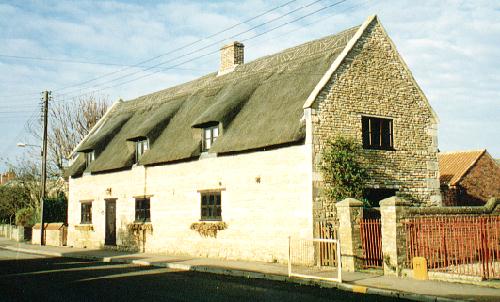 |
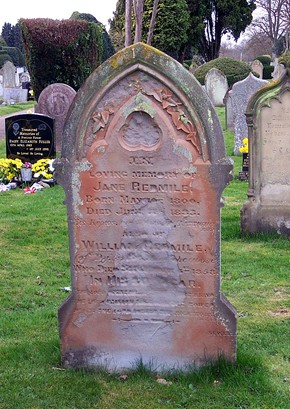 |
Jane was buried in the town cemetery at
Bourne on 21st June 1883 and a stone memorial marks her last resting place, the
inscription now badly eroded by wind and weather. She shares the
grave with her father, William Redmile, who died in 1858 but it is
not known where her mother, Ann, is buried.
The burial would also have been marked
by a graveside service, as was the custom of the day, and when the
funeral cortege passed through the town to the cemetery, blinds were
drawn in the houses along the route as a mark of respect for Aunt
Jane. |
|
|
A new housing development completed in Dyke in 2000 was named after Jane Redmile
to acknowledge her tireless work for the Baptist cause. The name was
chosen on the insistence of Councillor Don Fisher who admired her
contribution to the wider community. |
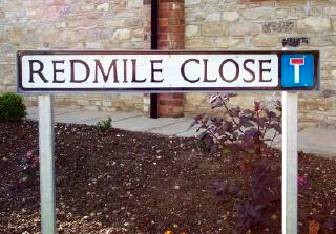 |
REVISED MARCH 2011
See also
William Redmile Garner Dyke village

Go to:
Main Index Villages
Index
|






